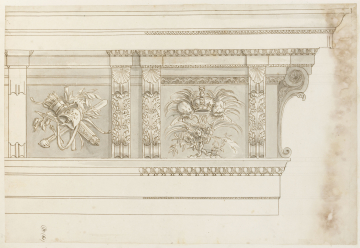
Browse
Reference number
Purpose
Aspect
Scale
Inscribed
Signed and dated
- Undated, but probably near beginning of period 1689-94
Medium and dimensions
Hand
Watermark
Notes
The pairing of the console brackets creates panels for the display of armorial and symbolic motifs analogous to the metopes of a Doric frieze. Next to the a familiar grouping of helmet, quiver of arrows, bow, swords and sprays of oak and olive leaves (symbolising the arms of battle at rest, and at peace), Gibbons has drawn, in the right-hand metope, a WM monogram above a rose plant with intertwined roots, suggesting a union of equals. Two winged putti heads bear up the crown against a backdrop of palm fronds. The relief motifs in the frieze compare very closely with those on the group of grey-wash designs for chimney-pieces in section 6/1, especially no. 5 (110/38). This has a similar group of quiver, bow, sprig of oak leaves and crown, flanked by winged cherubs's heads.
Literature
Level
Exhibition history
Sir John Soane's collection includes some 30,000 architectural, design and topographical drawings which is a very important resource for scholars worldwide. His was the first architect’s collection to attempt to preserve the best in design for the architectural profession in the future, and it did so by assembling as exemplars surviving drawings by great Renaissance masters and by the leading architects in Britain in the 17th and 18th centuries and his near contemporaries such as Sir William Chambers, Robert Adam and George Dance the Younger. These drawings sit side by side with 9,000 drawings in Soane’s own hand or those of the pupils in his office, covering his early work as a student, his time in Italy and the drawings produced in the course of his architectural practice from 1780 until the 1830s.
Browse (via the vertical menu to the left) and search results for Drawings include a mixture of Concise catalogue records – drawn from an outline list of the collection – and fuller records where drawings have been catalogued in more detail (an ongoing process).

